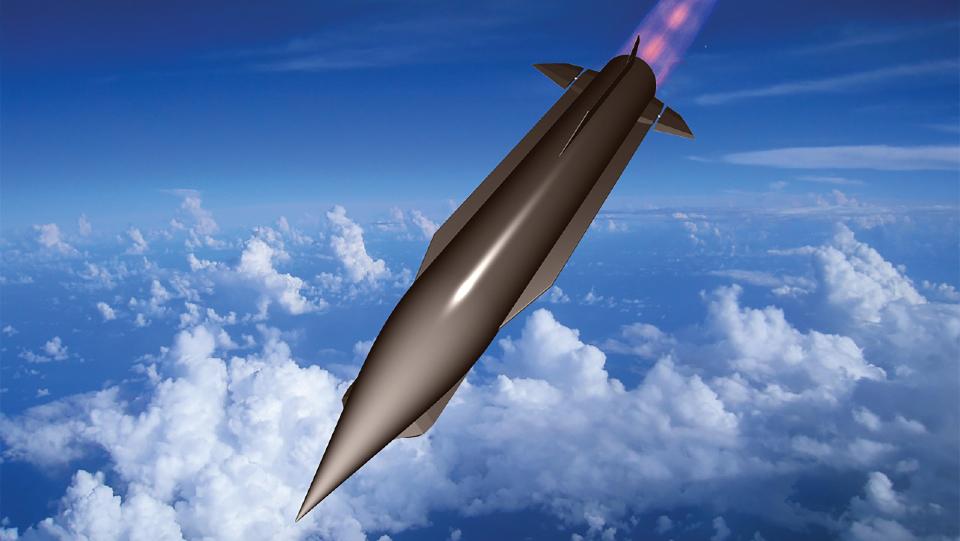
The DSTL published this concept of a notional ramjet/scramjet-powered missile to illustrate its hypersonic missile program.
The UK wants to secure a seat at the table of the world’s hypersonic powers. More than 15 years after the last UK-led hypersonic tests in the Australian desert, the UK Defense Ministry plans to set aside £1 billion ($1.3 billion) over seven years to build a sovereign hypersonic weapon capability that will allow it to produce its own weapons and collaborate in tandem with Australian and U.S. partners as part of the AUKUS defense pact.
In addition to the funding, which comes from the £6.6 billion that the UK Defense Ministry committed in 2021 to research and development, the hypersonic efforts are backed by a “clear political intent,” tender documents published in early July state. In short, the goal is to accelerate capability development.
- Work to be focused around AUKUS defense pact
- U.S.-UK Thresher project will be accelerated
The UK has a history of hypersonic flight research. The most recent trials, about 20 years ago, studied the HyShot dual-mode ramjet/scramjet engine while the ministry provided funding for the Sustained Hypersonic Flight Experiment (SHYFE) to explore technologies for a hypersonic missile. However, with the war in Afghanistan draining resources, interest in SHYFE faded, and the trials were called off.
Nevertheless, hypersonic efforts in China and Russia continued apace, and the emergence of systems such as the Chinese DF-17 and Russian Zircon has forced the UK and its allies to play catch-up. The UK’s newly refreshed command paper for structuring its armed services calls for a reprioritization to counter future threats by investing in novel weapons such as hypersonics.
The UK is looking at a three-track approach: buying a strategic Hypersonic Glide Vehicle via AUKUS, collaborating on existing weapon programs and setting up a national program to develop a weapon capability, likely a hypersonic cruise missile.
The newly established Team Hypersonics is leading the efforts, but the collaboration and development strands will be done through a Hypersonic Technologies and Capability Development Framework Agreement with industry.
The effort appears to be entirely separate from the UK’s work with France on the Future Cruise/Anti-Ship Weapon program, which aims to produce two weapons—one likely to be a high-speed but not hypersonic anti-ship weapon.
Indeed, France has embarked on its own hypersonic glide vehicle studies by launching a demonstrator, the eXperimental Maneuvering Vehicle (V-MAX) hypersonic glider, over the Atlantic Ocean at the end of June.
The UK’s work is focused around AUKUS, with hypersonic weapons added to the scope of the trilateral relationship in April 2022.
“These efforts show the seriousness with which hypersonic technologies are now seen, especially with regard to accelerating efforts to deploy a capability,” says James Bosbotinis, a UK-based independent defense and international affairs analyst.
He expects the collaboration work to prioritize UK integration into the Australian and U.S. bilateral Southern Cross Integrated Flight Research Experiment program, which could give the UK a potential hypersonic capability within the accelerated schedule. The sovereign capability would follow.
The tender documents from the UK Defense Ministry state that most of the country’s technological capability in hypersonics is at low technology readiness levels. The ministry see the framework as a way to begin bridging the gap by working with industry and academia.
The other routes to a UK hypersonic weapon capability are either to accelerate the joint U.S.-UK Thresher science and technology initiative (AW&ST April 6-19, 2020, p. 14), run by the UK Defense Science and Technology Laboratory (DSTL) and the U.S. Air Force Research Laboratory, or to run a technology demonstration program called HyLarc.
Details about HyLarc are scant, however, and the UK Defense Ministry did not address Aviation Week’s specific questions about the program. The ministry only provided a statement on the framework saying that the documents were to “stimulate industry interest.”
The framework will acquire capability through eight pillars of work: design and integration, modeling, airframe and power generation, propulsion, computing, seekers, lethal packages, and low-technology-readiness-level and academic work packages.
The new UK effort builds on the DSTL’s own hypersonic weapons program, running since 2022, which is aimed at delivering a hypersonic cruise missile technology demonstrator by the middle of the decade.
Separately, the DSTL is working with Reaction Engines, Rolls-Royce, the UK Royal Air Force’s Rapid Capabilities Office and the UK’s National Security Strategic Investment Fund to deliver the Hypersonic Air Vehicle Experimental (HVX) Program—announced at last year’s Farnborough Airshow—to explore reusable hypersonic air systems (AW&ST July 25-Aug. 7, 2022, p. 26). The HVX team is working on critical high-Mach/hypersonic technologies, including novel air-breathing propulsion architectures, innovative thermal management systems and advanced vehicle concepts.
